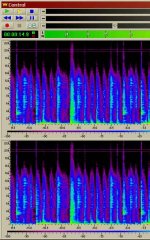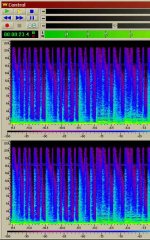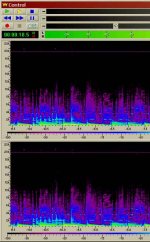Hello. After asking a highly knowledgeable friend, I've decided to ask the forum.
Why do I see a low-level frequency 'line' (FFT derived) during many recordings which appears to be around the 16KHz range? Moon Over Bourbon Street (Sting) on the Bring on the Night Disc 2 has it. Cosmic Thing (B-52's) on the Cosmic Thing disc has it to a lesser degree. Take Me To The River (Talking Heads) on the Sand in the Vaseline Disc 1 has one around 20KHz.
I cannot easily locate all the songs where I have noticed this phenomenon but it's there frequently and constantly. But why?
Did something go awry in during the recording session??
Thanks,
Joe
Why do I see a low-level frequency 'line' (FFT derived) during many recordings which appears to be around the 16KHz range? Moon Over Bourbon Street (Sting) on the Bring on the Night Disc 2 has it. Cosmic Thing (B-52's) on the Cosmic Thing disc has it to a lesser degree. Take Me To The River (Talking Heads) on the Sand in the Vaseline Disc 1 has one around 20KHz.
I cannot easily locate all the songs where I have noticed this phenomenon but it's there frequently and constantly. But why?
Did something go awry in during the recording session??
Thanks,
Joe
My only assumption is that the 'spurious' data/frequency is:
(1) From a malfunctioning recording device
(2) From an inessential device emanating frequency in the studio
(3) Some sort of psychoacoustic addition to the recording
What do you think? I am seeking any and all thoughts on this.
Thanks,
Joe
(1) From a malfunctioning recording device
(2) From an inessential device emanating frequency in the studio
(3) Some sort of psychoacoustic addition to the recording
What do you think? I am seeking any and all thoughts on this.
Thanks,
Joe
I became aware of this when first hearing CDs, and shopping for my first player. I likened it to a 'TV line whistle'
Although I could hear the noise clearly (and initially assumed that it was inherent in the CD system), none of the salesmen demonstrating the equipment claimed to be able to hear it!
At that time, it seemed to be a problem with virtually all CDs.
These days, I hear it less often - but perhaps that's just due to deterioration in my hearing.
I do wonder if it's this phenomenon which some listeners liken to 'fingernails down a blackboard'.
Although I could hear the noise clearly (and initially assumed that it was inherent in the CD system), none of the salesmen demonstrating the equipment claimed to be able to hear it!
At that time, it seemed to be a problem with virtually all CDs.
These days, I hear it less often - but perhaps that's just due to deterioration in my hearing.
I do wonder if it's this phenomenon which some listeners liken to 'fingernails down a blackboard'.
Well, I admit that high frequencies are harder to hear due to my age, attendance of many loud concerts at First Avenue (Minneapolis), and in possession of full-range output high-quality devices, but I have become curious to know why they are there.
Perhaps an audio engineer will provide the answer?
BTW, I can still always tell when a muted TV is on due to its inherent 'squeal.' haha
Thanks!
Joe
Perhaps an audio engineer will provide the answer?
BTW, I can still always tell when a muted TV is on due to its inherent 'squeal.' haha
Thanks!
Joe
Why do I see a low-level frequency 'line' (FFT derived)
How far down is this signal? Can you post an example?
If you're talking about the peaks at -92 to -100dB, this is caused by dithering techniques.
An interesting example can be found on the "Best of Chesky Classics & Jazz and Audiophile Test Disc Volume 3". Tracks 40 to 44 demonstate different dither levels, and you can see the peaks in the top end of the spectrum change with different dither, 16 bit, 20 bit and "high resolution" dithers.
An interesting example can be found on the "Best of Chesky Classics & Jazz and Audiophile Test Disc Volume 3". Tracks 40 to 44 demonstate different dither levels, and you can see the peaks in the top end of the spectrum change with different dither, 16 bit, 20 bit and "high resolution" dithers.
Well, I was kind of hoping that an audio engineer would definitively answer the question. A true audio engineer I am not but I do enjoy analyzing and writing software to process digital signals.
My guess is that the low-level continuous signal is either:
(1) caused by something such as a monitor or lighting ballast that emits radio frequency (much like a TV does), or
(2) added by the artist for some sort of psychoacoustic effect that would produce a high-frequency 'airyness' signature to their sound
I have yet to run my custom DSP software in such a way that would highly boost that 'low-level high-frequency' to hear how the track/song would sound (i.e. bring it from it's seeming -70dBFS to around -10dBFS). Then it's intent (or accidential inclusion) would become more apparent?
Nonetheless, I still find it interesting, heh.
Joe
My guess is that the low-level continuous signal is either:
(1) caused by something such as a monitor or lighting ballast that emits radio frequency (much like a TV does), or
(2) added by the artist for some sort of psychoacoustic effect that would produce a high-frequency 'airyness' signature to their sound
I have yet to run my custom DSP software in such a way that would highly boost that 'low-level high-frequency' to hear how the track/song would sound (i.e. bring it from it's seeming -70dBFS to around -10dBFS). Then it's intent (or accidential inclusion) would become more apparent?
Nonetheless, I still find it interesting, heh.
Joe
- Status
- This old topic is closed. If you want to reopen this topic, contact a moderator using the "Report Post" button.
- Home
- Source & Line
- Digital Source
- High-Frequency Noise in CD Recordings



